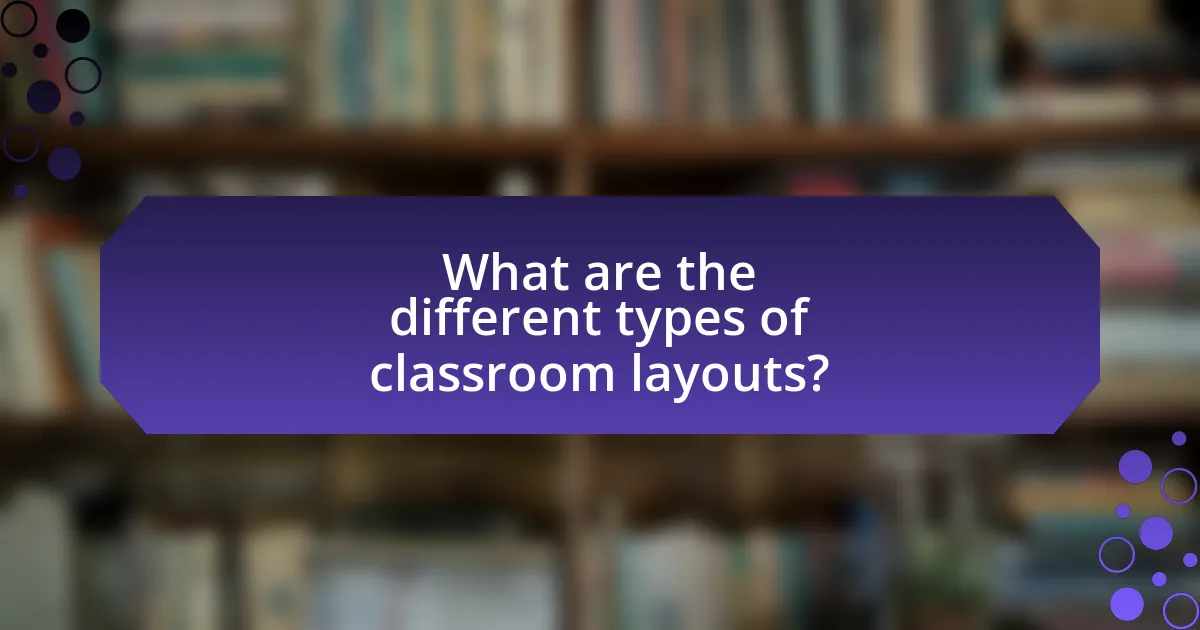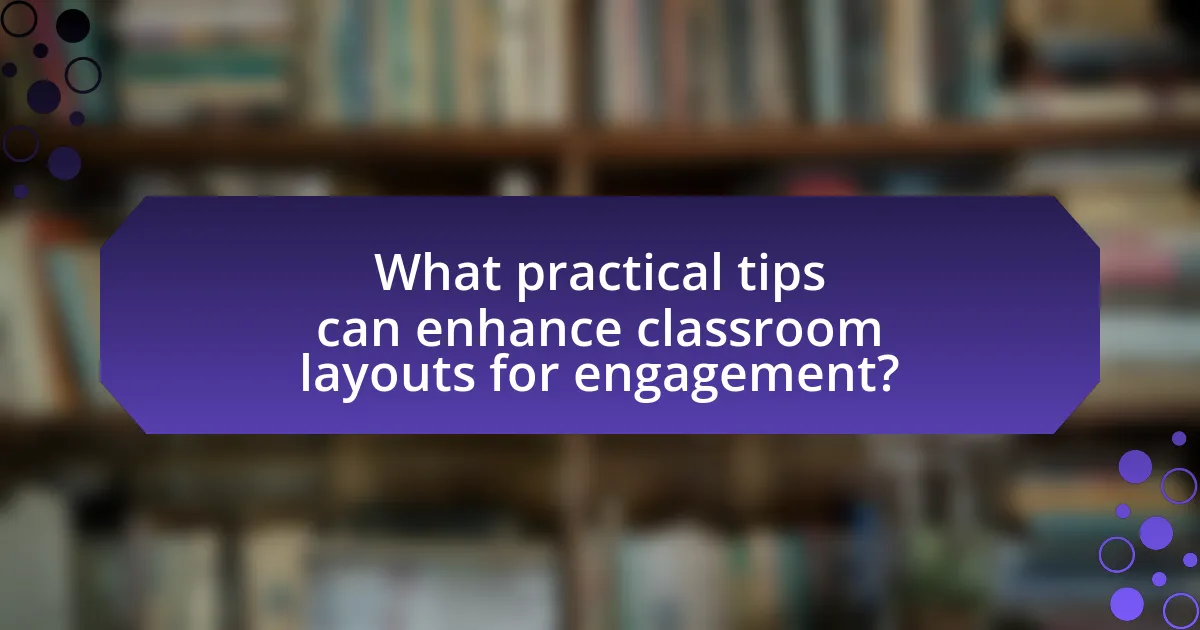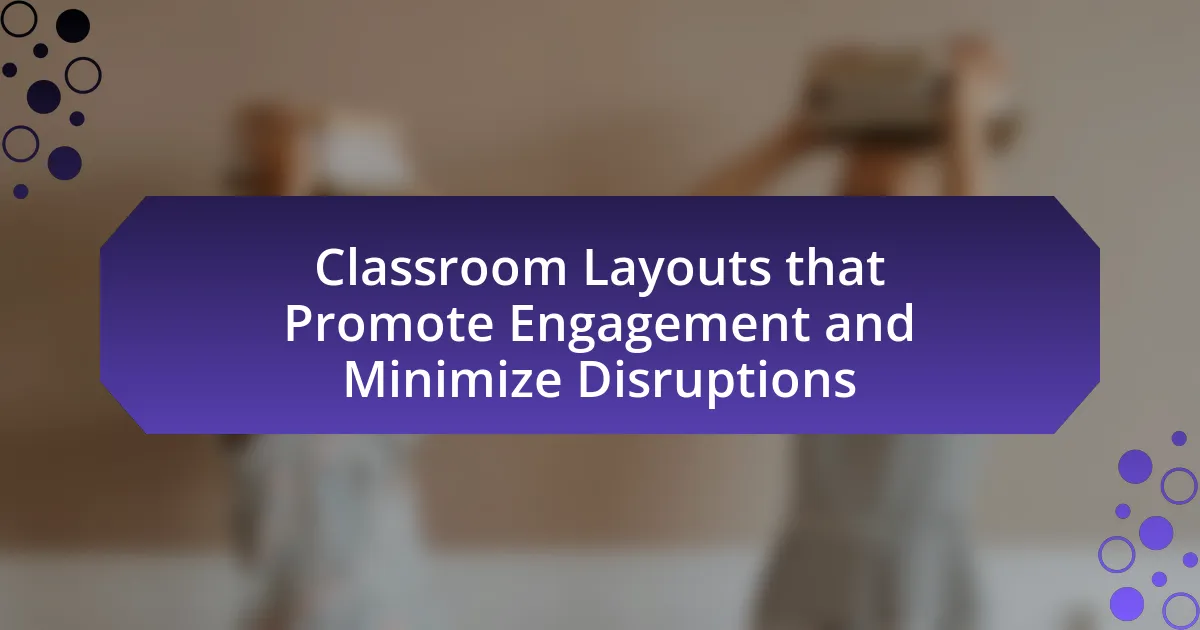Classroom layouts that promote engagement and minimize disruptions are essential for effective learning environments. This article examines various layout strategies, including flexible seating arrangements, collaborative group setups, and clear pathways for movement, which enhance student interaction and focus. It highlights the impact of different layouts on student engagement, behavior, and academic performance, supported by research findings. Additionally, the article discusses specific elements that contribute to effective layouts, strategies for reducing distractions, and the importance of adapting classroom designs to accommodate diverse teaching styles and learning needs.

What are Classroom Layouts that Promote Engagement and Minimize Disruptions?
Classroom layouts that promote engagement and minimize disruptions include flexible seating arrangements, collaborative group setups, and clear pathways for movement. Flexible seating allows students to choose their seating based on their learning preferences, which can enhance engagement; studies show that students in flexible environments report higher satisfaction and participation levels. Collaborative group setups, such as clusters or pods, encourage interaction and teamwork, fostering a sense of community and reducing off-task behavior. Clear pathways for movement help prevent congestion and distractions, allowing teachers to circulate easily and maintain classroom management. Research indicates that well-structured layouts can lead to improved academic performance and reduced behavioral issues, supporting the effectiveness of these designs in educational settings.
How do different classroom layouts impact student engagement?
Different classroom layouts significantly impact student engagement by influencing interaction, focus, and participation levels. For instance, traditional rows may limit collaboration and communication, while circular or group seating arrangements encourage discussion and peer interaction, leading to higher engagement. Research by the University of Salford found that classroom design can affect learning outcomes by up to 25%, highlighting the importance of layout in fostering an engaging learning environment. Additionally, flexible seating options allow for adaptability, catering to diverse learning styles and promoting active participation, further enhancing student engagement.
What specific elements of a layout contribute to increased engagement?
Specific elements of a layout that contribute to increased engagement include flexible seating arrangements, clear sightlines, and designated collaboration spaces. Flexible seating allows students to choose their preferred learning environment, which can enhance comfort and focus. Clear sightlines ensure that all students can see the instructor and instructional materials, promoting participation. Designated collaboration spaces encourage group work and interaction, fostering a sense of community and active learning. Research by the University of Salford indicates that classroom design can impact student performance by up to 25%, highlighting the importance of these layout elements in enhancing engagement.
How can layout choices reduce distractions in the classroom?
Layout choices can significantly reduce distractions in the classroom by strategically organizing furniture and resources to enhance focus and minimize visual and auditory interruptions. For instance, arranging desks in clusters can promote collaboration while reducing the likelihood of students being distracted by peers, as they are less likely to engage in off-task conversations. Additionally, positioning the teacher’s desk away from high-traffic areas can limit distractions from movement and noise, allowing students to concentrate better on lessons. Research indicates that classrooms designed with clear sightlines and minimal clutter lead to improved student attention and engagement, as evidenced by a study published in the Journal of Educational Psychology, which found that organized environments positively impact student learning outcomes.
Why is classroom layout important for minimizing disruptions?
Classroom layout is crucial for minimizing disruptions because it directly influences student engagement and behavior. An effective layout facilitates clear sightlines to the teacher and instructional materials, reducing distractions and promoting focus. Research indicates that classrooms designed with flexible seating arrangements and defined activity zones can lead to a 20% increase in on-task behavior, as students are less likely to be distracted by their peers or environmental factors. Additionally, a well-organized space allows for smoother transitions between activities, which further decreases the likelihood of disruptions.
What types of disruptions can be mitigated by effective layouts?
Effective layouts can mitigate disruptions such as noise interference, visual distractions, and movement congestion in classrooms. By strategically arranging furniture and resources, educators can create designated areas for different activities, reducing the likelihood of students being distracted by peers or external stimuli. Research indicates that classrooms designed with clear pathways and defined spaces for group work can decrease off-task behavior by up to 20%, thereby enhancing overall engagement and learning outcomes.
How does layout influence student behavior and interaction?
Classroom layout significantly influences student behavior and interaction by affecting how students engage with each other and their learning environment. For instance, a layout that promotes collaborative seating arrangements, such as clusters or U-shapes, encourages communication and teamwork among students, leading to increased participation and engagement. Research by the University of Salford found that classroom design can impact learning outcomes by up to 25%, highlighting the importance of spatial arrangements in fostering positive interactions. Additionally, layouts that minimize distractions, such as reducing visual clutter and ensuring clear sightlines to the teacher, help maintain student focus and reduce disruptive behaviors.
What are the key principles of effective classroom layouts?
The key principles of effective classroom layouts include flexibility, accessibility, and fostering interaction. Flexibility allows for various seating arrangements to accommodate different teaching styles and activities, enhancing student engagement. Accessibility ensures that all students can navigate the space easily, promoting inclusivity and minimizing disruptions. Fostering interaction through strategic seating arrangements encourages collaboration and communication among students, which is essential for active learning. Research indicates that classrooms designed with these principles can lead to improved student performance and satisfaction, as highlighted in studies by the University of Salford, which found that classroom design can significantly impact learning outcomes.
How can flexibility in layout design enhance learning experiences?
Flexibility in layout design enhances learning experiences by allowing educators to adapt the physical space to meet diverse learning needs and styles. This adaptability fosters collaboration, encourages active participation, and minimizes distractions, which are crucial for effective learning. Research indicates that classrooms designed with movable furniture and varied seating arrangements can increase student engagement by up to 30%, as they facilitate group work and interactive activities. Additionally, a study published in the Journal of Learning Spaces found that flexible layouts can lead to improved academic performance, as students feel more comfortable and motivated in environments that cater to their preferences.
What role does furniture arrangement play in classroom dynamics?
Furniture arrangement significantly influences classroom dynamics by affecting student interaction, engagement, and behavior. A well-organized layout can facilitate collaboration and communication among students, while a poorly arranged space may lead to distractions and disengagement. Research indicates that flexible seating arrangements, such as clusters or circles, promote active participation and foster a sense of community, enhancing overall learning outcomes. For instance, a study by Barrett et al. (2015) published in the journal “Building and Environment” found that classroom design, including furniture arrangement, can improve student performance by up to 25%. Thus, strategic furniture arrangement is crucial for creating an effective learning environment.
How can teachers assess the effectiveness of their classroom layout?
Teachers can assess the effectiveness of their classroom layout by observing student engagement and interaction during lessons. This can be measured through specific indicators such as student participation rates, the frequency of collaborative activities, and the level of on-task behavior. Research indicates that classroom layouts that facilitate group work and minimize distractions lead to higher engagement levels; for instance, a study by Barrett et al. (2015) in “The Impact of Classroom Design on Learning” found that flexible seating arrangements significantly improved student collaboration and focus. By analyzing these factors, teachers can determine if their layout supports an engaging learning environment.
What strategies can be implemented to improve classroom layouts?
To improve classroom layouts, strategies such as flexible seating arrangements, designated learning zones, and the use of technology can be implemented. Flexible seating allows students to choose their seating based on their learning preferences, which has been shown to enhance engagement and comfort. Designated learning zones, such as areas for group work, quiet study, and hands-on activities, help minimize distractions and cater to different learning styles. The integration of technology, such as interactive whiteboards and digital resources, can facilitate collaboration and keep students engaged. Research indicates that classrooms designed with these strategies can lead to increased student participation and improved academic performance.

What are the different types of classroom layouts?
The different types of classroom layouts include traditional, U-shape, group, and theater-style arrangements. Traditional layouts feature rows of desks facing the front, promoting direct instruction but limiting interaction. U-shape layouts encourage discussion and visibility among students, enhancing engagement. Group layouts consist of clusters of desks, fostering collaboration and teamwork. Theater-style arrangements prioritize presentations and lectures, maximizing seating capacity but minimizing interaction. Each layout serves distinct educational purposes and can influence student engagement and participation.
How do traditional layouts compare to modern, flexible designs?
Traditional layouts typically feature fixed desks arranged in rows, promoting a teacher-centered approach, while modern, flexible designs utilize movable furniture and varied configurations to foster collaboration and student engagement. Research indicates that flexible classroom designs can enhance student interaction and participation, with studies showing that such environments lead to improved academic performance and satisfaction. For instance, a study by the University of Salford found that classroom design can impact learning outcomes by up to 25%, highlighting the effectiveness of modern layouts in promoting engagement compared to traditional setups.
What are the advantages of a U-shaped classroom layout?
A U-shaped classroom layout enhances student engagement and minimizes disruptions by facilitating better interaction among students and between students and the instructor. This configuration allows all participants to see each other, promoting discussion and collaboration, which is supported by research indicating that face-to-face interaction increases student participation and learning outcomes. Additionally, the open design reduces distractions, as students are less likely to be isolated or distracted by activities occurring behind them, leading to a more focused learning environment.
How does a group seating arrangement foster collaboration?
A group seating arrangement fosters collaboration by facilitating direct communication and interaction among students. This layout encourages peer-to-peer engagement, allowing individuals to share ideas, discuss concepts, and work together on projects more effectively. Research indicates that collaborative learning environments, such as those created by group seating, enhance critical thinking and problem-solving skills, as students are more likely to engage in dialogue and exchange diverse perspectives. Studies show that classrooms designed for collaboration can lead to improved academic performance and increased student satisfaction, reinforcing the effectiveness of group seating arrangements in promoting teamwork and collective learning.
What layout options are best for specific teaching styles?
Collaborative layouts are best for cooperative learning styles, as they facilitate group work and interaction among students. In this layout, desks are arranged in clusters or circles, promoting communication and teamwork. Research indicates that such arrangements can enhance student engagement and improve learning outcomes by fostering a sense of community (Johnson & Johnson, 2014).
For direct instruction styles, traditional rows or columns are effective, allowing the teacher to maintain focus on the entire class while minimizing distractions. This layout supports clear visibility of the instructor and instructional materials, which is crucial for effective teaching (Marzano, 2007).
Flexible layouts, which allow for quick reconfiguration, are ideal for differentiated instruction. This adaptability supports various teaching methods and accommodates diverse learning needs, enabling teachers to tailor their approach based on student requirements (Tomlinson, 2014).
In summary, the choice of layout directly influences the effectiveness of different teaching styles, with collaborative layouts enhancing group work, traditional layouts supporting direct instruction, and flexible layouts accommodating diverse learning needs.
How can layouts support project-based learning environments?
Layouts can support project-based learning environments by facilitating collaboration and interaction among students. Flexible seating arrangements, such as clusters or pods, encourage teamwork and communication, essential for project-based activities. Research indicates that classroom design significantly impacts student engagement; for instance, a study by the University of Salford found that effective classroom layouts can enhance learning outcomes by up to 25%. Additionally, layouts that incorporate designated areas for group work and individual tasks help minimize distractions, allowing students to focus on their projects.
What layout is most effective for lecture-based instruction?
The most effective layout for lecture-based instruction is the traditional classroom layout, which features rows of desks facing the instructor. This arrangement maximizes visibility and minimizes distractions, allowing students to focus on the lecture. Research indicates that this layout enhances student engagement and retention of information, as it facilitates direct eye contact between the instructor and students, promoting a more interactive learning environment. Studies have shown that when students can clearly see the instructor and presentation materials, their comprehension and participation levels increase significantly.

What practical tips can enhance classroom layouts for engagement?
To enhance classroom layouts for engagement, educators should implement flexible seating arrangements that promote collaboration and interaction among students. Research indicates that varied seating options, such as group tables, bean bags, and standing desks, can increase student participation and focus. For instance, a study by the University of Salford found that classroom design can impact learning outcomes, with flexible layouts leading to improved student engagement and academic performance. Additionally, incorporating technology stations and designated areas for group work can further facilitate active learning and collaboration, making the classroom environment more dynamic and engaging.
How can teachers create a more engaging classroom environment?
Teachers can create a more engaging classroom environment by implementing flexible seating arrangements that encourage collaboration and interaction among students. Research indicates that classrooms designed with varied seating options, such as bean bags, standing desks, and group tables, can enhance student engagement and participation. For instance, a study published in the Journal of Educational Psychology found that students in flexible seating environments reported higher levels of motivation and focus compared to traditional desk setups. Additionally, incorporating technology, such as interactive whiteboards and tablets, can further stimulate student interest and facilitate active learning.
What are some simple changes that can be made to existing layouts?
Simple changes that can be made to existing classroom layouts include rearranging furniture to create flexible seating arrangements, incorporating movable partitions to define spaces, and utilizing wall space for interactive learning tools. Rearranging furniture allows for various configurations, such as group work or individual study, which can enhance student engagement. Movable partitions can create distinct areas for different activities, minimizing distractions. Utilizing wall space for whiteboards or bulletin boards encourages interaction and collaboration among students. These adjustments have been shown to improve focus and participation in educational settings.
How can technology integration influence classroom layout decisions?
Technology integration can significantly influence classroom layout decisions by necessitating flexible arrangements that accommodate various digital tools and collaborative learning environments. For instance, the presence of interactive whiteboards and student devices often requires layouts that facilitate group work and easy access to technology, leading to configurations such as clusters or U-shaped seating. Research indicates that classrooms designed with technology in mind can enhance student engagement and participation, as evidenced by a study from the University of Minnesota, which found that flexible seating arrangements improved student collaboration and learning outcomes. Thus, the integration of technology directly shapes how classrooms are organized to optimize both engagement and functionality.
What common challenges do teachers face with classroom layouts?
Teachers commonly face challenges with classroom layouts that hinder student engagement and increase disruptions. One significant issue is the arrangement of desks, which can limit visibility and interaction among students, making it difficult for teachers to facilitate group work or discussions. Additionally, inadequate space for movement can lead to overcrowding, causing distractions and discomfort. Research indicates that classroom design directly impacts student behavior and learning outcomes; for instance, a study published in the Journal of Learning Spaces found that flexible seating arrangements can enhance collaboration and reduce off-task behavior. Therefore, effective classroom layouts are crucial for promoting an engaging learning environment.
How can teachers overcome space limitations in their classrooms?
Teachers can overcome space limitations in their classrooms by utilizing flexible furniture arrangements and incorporating vertical storage solutions. Flexible furniture, such as movable desks and chairs, allows for reconfiguration based on activities, promoting collaboration and maximizing available space. Vertical storage, including shelves and wall-mounted organizers, helps to free up floor space while keeping materials accessible. Research indicates that classrooms designed with adaptable layouts can enhance student engagement and reduce disruptions, as evidenced by a study published in the Journal of Educational Psychology, which found that effective classroom design positively impacts learning outcomes.
What strategies can help manage noise levels in active layouts?
To manage noise levels in active layouts, implementing acoustic treatments and strategic furniture arrangement is essential. Acoustic panels, carpets, and curtains can absorb sound, reducing overall noise levels in the classroom. Additionally, arranging furniture to create distinct zones for different activities can help contain noise within specific areas, minimizing distractions. Research indicates that classrooms designed with sound-absorbing materials can lower noise levels by up to 50%, enhancing the learning environment and promoting student engagement.



